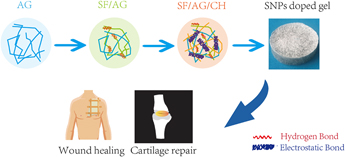Crossref Citations
This article has been cited by the following publications. This list is generated based on data provided by
Crossref.
Li, Zhi
Chen, Li
Xu, Mengting
Ma, Yan
Chen, Lei
and
Dai, Fangyin
2020.
Double crosslinking hydrogel with tunable properties for potential biomedical application.
Journal of Polymer Research,
Vol. 27,
Issue. 9,
Francius, Grégory
Cervulle, Manon
Clément, Eloïse
Bellanger, Xavier
Ekrami, Saeid
Gantzer, Christophe
and
Duval, Jérôme F. L.
2021.
Impacts of Mechanical Stiffness of Bacteriophage-Loaded Hydrogels on Their Antibacterial Activity.
ACS Applied Bio Materials,
Vol. 4,
Issue. 3,
p.
2614.
Bandatang, Naruedee
Pongsomboon, Song-amnart
Jumpapaeng, Punnapat
Suwanakood, Pitchayaporn
and
Saengsuwan, Sayant
2021.
Antimicrobial electrospun nanofiber mats of NaOH-hydrolyzed chitosan (HCS)/PVP/PVA incorporated with in-situ synthesized AgNPs: Fabrication, characterization, and antibacterial activity.
International Journal of Biological Macromolecules,
Vol. 190,
Issue. ,
p.
585.
Johari, Narges
Khodaei, Azin
Samadikuchaksaraei, Ali
Reis, Rui L.
Kundu, Subhas C.
and
Moroni, Lorenzo
2022.
Ancient fibrous biomaterials from silkworm protein fibroin and spider silk blends: Biomechanical patterns.
Acta Biomaterialia,
Vol. 153,
Issue. ,
p.
38.
Govindasamy, G Ambarasan
S. M. N. Mydin, Rabiatul Basria
Effendy, Wan Nuramiera Faznie Wan Eddis
and
Sreekantan, Srimala
2022.
Novel dual-ionic ZnO/CuO embedded in porous chitosan biopolymer for wound dressing application: Physicochemical, bactericidal, cytocompatibility and wound healing profiles.
Materials Today Communications,
Vol. 33,
Issue. ,
p.
104545.
Ortiz, J. Andrés
Sepúlveda, Francesca Antonella
Panadero-Medianero, Concepción
Murgas, Paola
Ahumada, Manuel
Palza, Humberto
Matsuhiro, Betty
and
Zapata, Paula A.
2022.
Cytocompatible drug delivery hydrogels based on carboxymethylagarose/chitosan pH-responsive polyelectrolyte complexes.
International Journal of Biological Macromolecules,
Vol. 199,
Issue. ,
p.
96.
Aye, San Seint Seint
Zhang, Zhi-Hong
Yu, Xin
Yu, Heidi
Ma, Wen-Dong
Yang, Kai
Liu, Xin
Li, Jian
and
Li, Jing-Liang
2022.
Silk Hydrogel Electrostatically Functionalized with a Polycationic Antimicrobial Peptide: Molecular Interactions, Gel Properties, and Antimicrobial Activity.
Langmuir,
Vol. 38,
Issue. 1,
p.
50.
González-Restrepo, David
Zuluaga-Vélez, Augusto
Orozco, Lina M.
and
Sepúlveda-Arias, Juan C.
2024.
Silk fibroin-based dressings with antibacterial and anti-inflammatory properties.
European Journal of Pharmaceutical Sciences,
Vol. 195,
Issue. ,
p.
106710.
Igbokwe, Victor C.
Ball, Vincent
Benzaamia, Nour‐Ouda
Gree, Simon
Hellé, Sophie
Soubirou‐Blot, Juliette
Nardin, Corinne
and
Ploux, Lydie
2024.
Sucrose and Glycerol Additives: A Way to Tune the Biological and Physicochemical Properties of Agarose Hydrogels?.
Macromolecular Materials and Engineering,
Vol. 309,
Issue. 11,
Najihah, A.Z.
Hassan, Mohamad Zaki
and
Ismail, Zarini
2024.
Current trend on preparation, characterization and biomedical applications of natural polysaccharide-based nanomaterial reinforcement hydrogels: A review.
International Journal of Biological Macromolecules,
Vol. 271,
Issue. ,
p.
132411.



